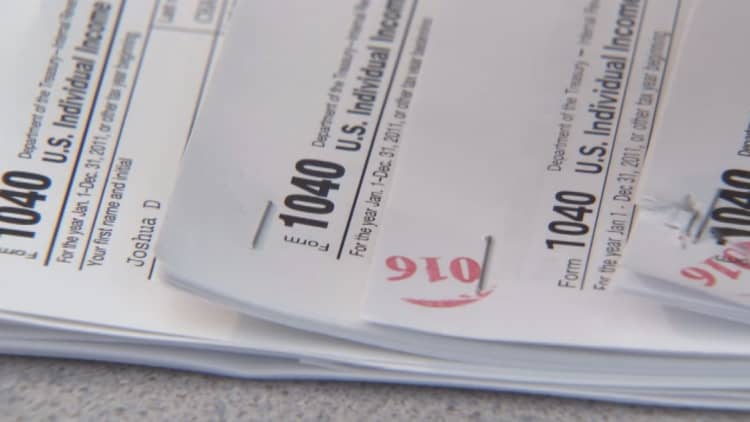A large tax refund may feel like free money. It isn't.
This year about 7 out of 10 taxpayers will get some money back from Uncle Sam.
Early bird filers who submitted their returns when tax season opened Jan. 29 may get their money in the coming weeks.
The IRS expects to receive nearly 155 million tax returns this season.
Many tax refund recipients plan to put that money to work.
About a third of taxpayers getting a refund expect to save or invest the money, while nearly 3 in 10 will pay down debt, according to Bankrate.com.
Here's the bad news: If the IRS sends you a huge check this spring, it means you've likely overpaid on taxes throughout the year.
"A large refund from the IRS may seem like an advantage, but it isn't the best or most effective use of your cash flow," said Tim Steffen, director advanced planning at Robert W. Baird & Co.
"You're basically giving the IRS an interest-free loan," he said.
Know your withholding
If you're an employee, your employer gave you a Form W-4 when you were hired, which you can adjust to make sure the right amount of income tax is withheld from your paycheck.
On the form, you'll make note of your spouse, your dependents and your filing status; these are your "personal allowances." The more allowances you have, the less tax will be withheld.
"Some people read the form and think, 'I'm married and have three kids,'" said Cari Weston, director of tax practice and ethics at the American Institute of CPAs. "They end up with five allowances and owe substantial taxes at the end of the year."
To make things more complicated, the IRS is making internal tweaks to reflect the changes from the Tax Cuts and Jobs Act. The agency released new withholding tables, which take effect this year.
The IRS is also working on a calculator and a new Form W-4 to help you figure out the correct withholding based on the new tax code.
Tax uncertainty
Use your 2017 tax return to get an idea of how much you ought to withhold this year.
To ensure that you avoid a penalty for underpayment of estimated taxes, you should aim to pay in 2018 at least 100 percent of the prior year's liability, said Jeffrey Levine, CEO and director of financial planning at BluePrint Wealth Alliance in Garden City, New York.

This doesn't mean that you won't owe in April 2019. Rather, it means the IRS won't charge you the penalty and interest next year for coming up short on your taxes.
"If you see your tax rate increase substantially, you might owe a larger amount over the withholding," said Levine. "Aim for that 100 percent: It's a better method of avoiding the underpayment penalty."
Tailor your tax load
Here's how to evaluate your withholding and make sure it's just right for you.
- Review your W-4: Striking a balance for withholding will be based on your salary, your spouse's earnings and the tax bracket you're in.
We're in a year with many changes to the withholding table, plus a reduction in federal income tax rates. You may be taking home a slightly larger paycheck, but you should make sure you aren't withholding too few taxes.
Talk to your accountant: Filers who withheld fewer taxes because they itemized on their returns will need to revisit their withholding. That's because the new law does away with a lot of itemized deductions and places a $10,000 cap on state and local tax deductions.
Fewer filers are expected to itemize in 2018 because the new tax law has doubled the standard deduction. Under the previous law, about 49 million taxpayers — roughly 3 in 10 individuals — filed itemized returns, according to the Urban-Brookings Tax Policy Center.If you fall into that category, you may need to update your allowances in 2018 to ensure you're withholding the right amount of tax.
Calculating your withholding is more complicated if you have multiple sources of income: distributions from retirement accounts or cash from a rental property. You'll need to make estimated quarterly tax payments in those cases, Steffen said.
"Work with a CPA to do a projection and figure out what your tax liability will be at the end of the year," he said. "In a perfect scenario, you'll have a balance due when you file your return, but not one that's large enough to create a penalty."
- Avoid tax arbitrage: If you withhold less in taxes because you have bigger plans with your paycheck, bear in mind that you'll owe Uncle Sam next year. Don't gamble your cash.
"Some people do foolish things: 'If I invest the money and make 7 percent this year, and I beat the IRS' penalty, then I'm ahead,'" said Levine. "If you've deliberately underpaid, the money should go someplace safe because this is a really short time horizon," he said.
More from Personal Finance
Here's what most Americans do with their tax refunds
10 tax changes you need to know for 2018
Tax bill creates a possible $11 million windfall for your kids
WATCH: Here's how to tell if you could owe the IRS more in 2019



